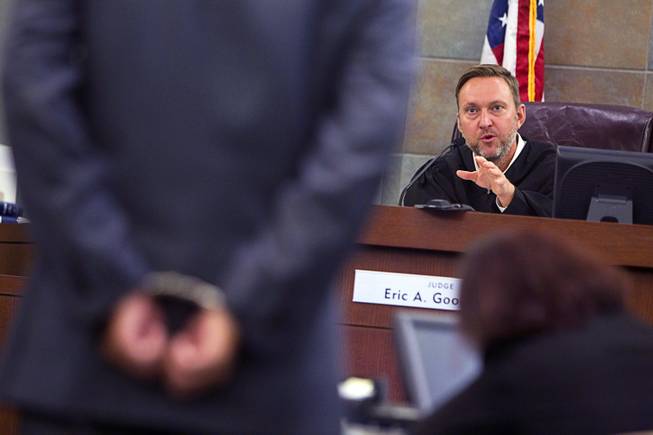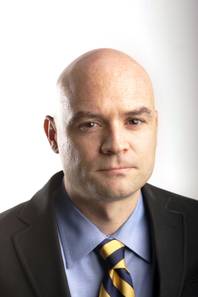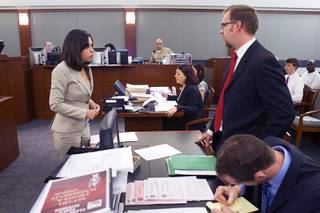
Judge Eric Goodman speaks to a man at the Regional Justice Center Tuesday, July 23, 2013. The man was handcuffed and almost taken to jail but Goodman eventually allowed the man to remain free while the case was pending.
Thursday, Aug. 8, 2013 | 2 a.m.

J. Patrick Coolican
Sun coverage
The woodwork, soft lighting and perfect temperature in Justice Court Department 11 convey civilization and solidity, in stark contrast to the chaotic lives of many of the defendants now before Judge Eric Goodman.
His Tuesday morning courtroom welcomes a bevy of defendants caught up in weekend shenanigans, many of them so-called “frequent fliers” here for the umpteenth time for drug paraphernalia, prostitution, petty larceny, public drunkenness. Later, Goodman will preside over preliminary hearings for more serious crimes. Defendants are hauled in from the jail, handcuffed and connected to one another by a chain.
“My concern is the drug issue,” says the judge to a defense lawyer. Unless speaking directly to a defendant, the judges and attorneys will often speak about a defendant like he’s not there. “I don’t know if you read the police report but he said he was on an eight-day bender. And there are five failures to appear.” The defendant just stands there, told by his lawyer to keep quiet.
To another defendant, the judge says bluntly: “At this point, I consider you a career criminal.”
A man who has served six days in jail after being found with a hypodermic needle pleads guilty, is given credit for time he’s already served, and is released — probably to find a good hit of heroin or meth, and another needle.
A few prostitutes plead guilty to soliciting or its more subtle cousin, trespassing. They usually pay a small fine. Out they go. I’m told they’ll be back.
Some defendants are here to show they’ve completed their drug “counseling” — it’s more like drug “awareness” and not drug treatment by any means — and community service at a local nonprofit such as HELP of Southern Nevada. They pay their fines and are released from the system.
One defendant fails to appear in court, and Goodman issues an arrest warrant. Another no-show, another bench warrant. And yet another. It seems likely the people who are no-shows in court were once frequently absent from school.
Alicia Blanton faces a preliminary hearing for an alleged assault. She says her former roommate stole her dogs, her electronics and other household items.
Prosecutors say Blanton went over to the roommate's new residence and hit the woman in the head with a baseball bat, knocking her unconscious.
• • •
The traditional metaphor for the justice system is a scale, signifying the strength of each side’s argument or the imperative to balance justice with mercy.
The more accurate metaphor is a machine, a grinding, sometimes rickety machine, lubricated by plea deals, that ostensibly applies justice to people — dumping some into the local jail, others to the High Desert State Prison and releasing a few back on the street or into a supervision program such as probation. Very few of the presumed innocent are found innocent.
This gloomy reality is evident after spending even just a few days at the Regional Justice Center. What unfolds is not the tidy, self-satisfied three acts of a TV courtroom, but a train of repeat criminality at once dizzying and insipid — drugs, grand larceny, burglary, assault, probation violation, prostitution, guns, drugs.
• • •
Twenty-five-year-old Percy Hawkins, a prolific if incompetent thief, is standing before District Judge Michelle Leavitt, pleading for mercy. The judge is deciding what to do with him because he violated probation.
Hawkins was put on probation after he and his brother Zaion and an unknown third suspect had walked into the Apple Store in Town Square a couple of years ago, yanked iPads off their security chains and ran out.
That police recognized him on the surveillance tape should not have surprised Hawkins, who is squat but solid, his hair unruly like his own brief biography.
He had at least nine contacts with the juvenile justice system before graduating to the adult system in 2006, after which he was convicted of crimes such as robbery, burglary and possession of stolen property, always bargaining for plea agreements that cleared away additional charges. Then there were the times he was arrested but not charged.
So, given his rich history, Hawkins was surely known to police, a familiar presence on the grainy security video most of us assume is ubiquitous. They executed a search warrant on his residence and found a stolen iPad.
After pleading guilty to that crime, Hawkins was given probation. His probation officer told him to get a general equivalency diploma, apply for jobs, do his community service and stay out of trouble.
To compensate for his poor handwriting, his girlfriend and mother filled out job applications for Hawkins at fast food restaurants and retail stores, though the likelihood of any of them hiring a convicted thief was nil. He had signed up for high school-equivalency classes but only attended a couple and could not say in court what he had learned. He was told to perform community service but claimed he did so at a private business — a pet store. He could not recall the name of store. He frequently missed his curfew, and like a recalcitrant adolescent, he told the incredulous judge that it was OK because he had called to tell the house arrest administrators that he would be late.
And today, his pleas for mercy will fall on hardened ears. Judge Leavitt revokes his probation and sends him back to state prison. And so Percy Hawkins takes another trip around the gold-plated revolving door of the criminal justice system, at a cost to Nevada taxpayers, once inside the prison, of more than $20,000 per year.
After Leavitt orders him back to prison, she takes a short recess.
When she leaves the courtroom, Hawkins yells a sexist obscenity.
“And the true character comes out,” Brian Kochevar says to me.
Kochevar, who is observing the action, leads a general litigation team for the District Attorney. He says Hawkins is a prime candidate for what he calls “escalation.”
“Unfortunately, many who go to prison will hang out with criminals and learn how to do new crimes,” he says.
The data tell us that when Hawkins is eventually released, he will probably be without skills or an education or any of the habits of a disciplined citizen. Perhaps what had been burglaries will become strong arm robberies, and maybe a robbery will go sideways, and maybe someone will die.
• • •
We hear and see and read a lot about sensational crime, about sociopaths committing grisly murders or Hollywood glitterati caught coking in an Escalade.
The grim reality of the criminal justice system, however, is both more mundane and more remarkable than any of that, and it is often embodied by the likes of Percy Hawkins — a seemingly limitless supply of mostly young, often uneducated offenders with a history of drug and alcohol use and a near total abdication of personal responsibility, let alone any responsibility for their families or their communities.
By the same token, the community has often shirked its own responsibility to protect these now fallen citizens during childhoods that were often marked by abuse and neglect. To say nothing of the failure to provide them with an education or health care.
The Regional Justice Center is often the site of the latest chapter in an ongoing, lifelong tragedy that was usually years in the making. In a way, it’s a kind of collective crime scene.
It begins with a failure that is elemental and begins in the womb.
“There’s no doubt many of these situations are caused by poor parenting, or no parenting,” says Kochevar, who is stoic about life at the courthouse, saying that in his family and church he finds relief from the creeping despair of the job.
Kochevar says criminal behavior, while ultimately the responsibility of the defendants, can often be traced to absent or indifferent or cruel parenting — the children learning, as they do, from the parents.
Maybe someone will alert the authorities about abuse or neglect, but often not.
In one case I happened upon at the courthouse, a group of young boys had been engaging in sex acts with each other for years until one of them tried to commit suicide. Now the oldest, who had been abused himself and was 17 when he was arrested, is serving 15 years in state prison for crimes that began when he was just 11.
Even when authorities are alerted, the foster system often fails its charges.
“We as a community are the parents of these children in the foster system, and I feel like we’re failing them,” says a defense attorney who has clients who have come from the foster system.
She’ll ask them if she can call someone — any family or a former foster parent — to appear at a sentencing, and sometimes they have no one at all.
Social isolation, the kind experienced by neglected children, is linked to poor physical health, including brain health and willpower. Poor physical health is tied to academic deficits, made worse by a school district universally regarded as mediocre at best, especially for poor and minority children.
Mental illness goes undiagnosed and untreated, so it’s no surprise that the Clark County Detention Center is the region’s largest psychiatric facility.
Nevada spends just one-tenth of 1 percent of its state budget on drug prevention, treatment and research, according to the National Center on Addiction and Substance Abuse at Columbia University. It’s far less than other states, even as prosecutors and defense attorneys alike estimate that three-fourths or more of the defendants have some substance abuse problem.
Neglected children, mediocre schools, untreated physical and mental illness — the resulting stew of pathologies is dumped on the courthouse steps.
District Attorney Steve Wolfson and his roughly 100 prosecutors filed nearly 52,000 felony, gross misdemeanor, and misdemeanor cases in 2012.
And this effort to keep the public safe from this skein of social dysfunction turns out to be quite expensive.
The Nevada Department of Corrections budget is nearly $300 million this year, and the Clark County Detention Center will cost $179 million. Metro’s budget is nearly $500 million. The District Attorney, public defenders, juries, district and justice courts and the juvenile system add up to nearly $190 million more. The sum is well more than $1 billion. And that estimate leaves out Henderson and North Las Vegas police and municipal courts.
Then there’s hidden costs such as higher insurance rates and more expensive goods and services to pay for extra security and grainy videos to deal with property crimes.
But that’s nothing compared to the damage to our sense of well-being. And worst of all, the incalculable physical and psychic costs to victims of violent crime.
• • •
District Court Judge Jesse Walsh sentences a slight young man to 12 to 36 months for statutory sexual seduction — legalese for having sex with an underage girl.
A corrections officer scribbles a note and hands it to me. It reads: “No GED. Can’t make a complete sentence. Drug/alcohol issues. Sentenced to prison. Small physique. What do you think his future looks like?”
A woman is in Justice Court on an $8,000 bad check case. Her attorney says she is getting out of a violent domestic relationship and seeking stability.
A homeless man is here on three trespassing citations.
Goodman: “Do you have any place to go?”
Defendant: “No. I have no ID either. Someone stoled it.”
The man is apparently a military veteran, so he’ll go to Veterans Court, created by Clark County to offer a legal setting that is especially sensitive to the issues of veterans.
The attorney often tasked with defending some of this unfortunate tribe is Robert O’Brien, an energetic 37-year-old graduate of Rutgers School of Law who worked in corporate law to pay off some school loans before turning to his passion and becoming a public defender. He takes regular swigs off a big Starbucks cup. At any one time, he’s defending between 100 and 120 clients who are in the criminal justice machine.
He says his goal is to help his clients preserve their dignity while confined in a system constantly seeking to strip them of it.
O’Brien believes many of the defendants are just as often themselves victims, caught up in the vortex of a modern criminal justice system that during the past 25 years has instituted ever harsher punishments, giving us the highest incarceration rate on the planet.
“You have to have a lot going right for you in your life to get out of the justice system. That’s not a lot of the people who are getting arrested,” he says.
“So many parole/probation reports read the same,” O’Brien says. “Meth user since 14. Dropped out of high school.”
Clients tell him they just want some kind of decent drug program. But for many, he says, “It’s just too late.”
O’Brien recalls a client who heard that the Nevada Department of Corrections has a good meth treatment program, so he copped to a bank robbery he didn’t commit. When that didn’t work, he went out and robbed a bank.
Even the most earnest struggle to get out of the system, O’Brien says. Proof of their community service gets lost. A car fails on the way to a court appearance.
With a criminal record, they struggle to find work. Their friends and family are also addicts or criminals, and just being around them might violate terms of probation.
But as Kochevar points out, prosecutors are not social workers. Their job is to achieve justice as defined by the Legislature. Justice, prosecutors say, does not mean prison in every case, but the protection of the public is their top priority, and if jail it must be, then so be it.
• • •
In District Court, the beat goes on.
Defendant had a half ounce of meth, selling to support the habit. Criminal history: nine misdemeanors. He’s visibly relieved when the judge suspends a prison sentence, giving him one more shot to shed his meth addiction.
Possession of stolen vehicle, 12 to 30 months.
Burglary, repeat offender, 12 to 30 months.
Probation revoked, 24 to 60 months on the underlying charge of assault with a deadly weapon.
A prostitute is a no-show. Her attorney says he’ll try to find her. He knows she had been in an abusive relationship.
Around the courthouse, there’s a common refrain: Yesterday’s victim is today’s defendant.
And the justice machine will be grinding again tomorrow, and the next day and the next.


Join the Discussion:
Check this out for a full explanation of our conversion to the LiveFyre commenting system and instructions on how to sign up for an account.
Full comments policy